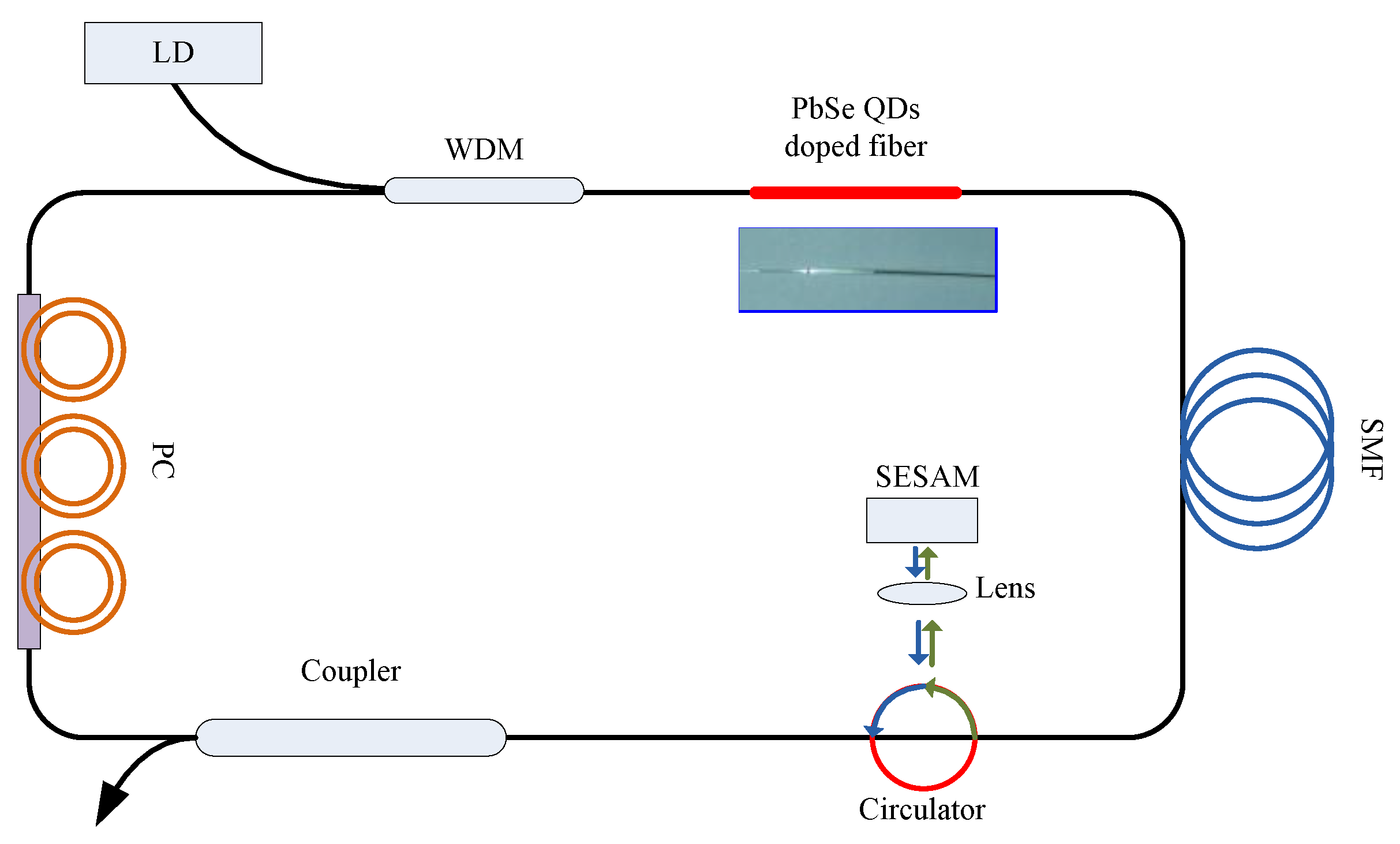PbSe Quantum Dot Doped Mode-Locked Fiber Laser
Abstract
1. Introduction
2. Materials and Methods
3. Results
4. Discussion
Author Contributions
Funding
Institutional Review Board Statement
Informed Consent Statement
Data Availability Statement
Conflicts of Interest
References
- Levichev, N.; Tomás García, A.; Duflou, J.R. Monitoring opportunities in fiber laser flame cutting. Lasers Manuf. Mater. Process. 2021, 8, 491–510. [Google Scholar] [CrossRef]
- Han, Y.; Guo, Y.B.; Gao, B.; Ma, C.Y.; Zhang, R.H.; Zhang, H. Generation, optimization, and application of ultrashort femtosecond pulse in mode-locked fiber lasers. Prog. Quant. Electron. 2020, 71, 100264. [Google Scholar] [CrossRef]
- Wei, K.H.; Zhou, X.F.; Lai, X.M. 3.8-μm Mid-infrared laser quasi-synchronously pumped by a MOPA structured picosecond Yb fiber amplifier with multi-pulse operation. IEEE Photon. J. 2016, 8, 1–5. [Google Scholar] [CrossRef]
- Chang, G.Q.; Wei, Z.Y. Ultrafast fiber lasers: An expanding versatile toolbox. iScience 2020, 23, 101101. [Google Scholar] [CrossRef] [PubMed]
- Traxer, O.; Keller, E.X. Thulium fiber laser: The new player for kidney stone treatment? A comparison with Holmium: YAG laser. World J. Urol. 2020, 38, 1883–1894. [Google Scholar] [CrossRef] [PubMed]
- Xu, N.N.; Yang, W.Q.; Zhang, H.Z. Nonlinear saturable absorption properties of indium selenide and its application for demonstrating a Yb-doped mode-locked fiber laser. Opt. Mater. Express 2018, 8, 3092–3103. [Google Scholar] [CrossRef]
- Sun, R.Y.; Guo, L.G.; Shang, X.X.; Zhang, H.N.; Yue, Q.Y. Efficient saturable absorber based on ferromagnetic insulator Cr2Ge2Te6 in Er-doped mode-locked fiber laser. Nanomaterials 2022, 12, 751. [Google Scholar] [CrossRef] [PubMed]
- Tang, G.W.; Qian, G.W.; Lin, W.; Shi, Z.G.; Yang, Y.; Dai, N.L.; Qian, Q.; Yang, Z.M. Broadband 2 μm amplified spontaneous emission of Ho/Cr/Tm: YAG crystal derived all-glass fibers for mode-locked fiber laser applications. Opt. Lett. 2019, 44, 3290–3293. [Google Scholar] [CrossRef] [PubMed]
- Li, Y.; Murthy, R.S.; Zhu, Y.R.; Zhang, F.Y.; Tang, J.N.; Mehrabi, J.N.; Kelly, K.M.; Chen, Z.P. 1.7-Micron optical coherence tomography angiography for characterization of skin lesions-a feasibility study. IEEE Trans. Med. Imaging 2021, 40, 2507–2512. [Google Scholar] [CrossRef] [PubMed]
- Nishizawa, N.; Kawagoe, H.; Yamanaka, M.; Matsushima, M.; Mori, K.; Kawabe, T. Wavelength dependence of ultrahigh-resolution optical coherence tomography using supercontinuum for biomedical imaging. IEEE J. Sel. Top. Quant. 2018, 25, 1–15. [Google Scholar] [CrossRef]
- Romano, C.; Jaouën, Y.; Tench, R.E.; Delavaux, J.M. Ultra-flat supercontinuum from 1.95 to 2.65 µm in a nanosecond pulsed Thulium-doped fiber laser. Opt. Fiber Technol. 2020, 54, 102113. [Google Scholar] [CrossRef]
- Wang, Y.Y.; Dai, S.X. Mid-infrared supercontinuum generation in chalcogenide glass fibers: A brief review. PhotoniX 2021, 2, 9. [Google Scholar] [CrossRef]
- Moon, H.; Lee, C.M.; Lee, W.; Kim, J.; Chae, H. Stability of quantum dots, quantum dot films, and quantum dot light--emitting diodes for display applications. Adv. Mater. 2019, 31, 1804294. [Google Scholar] [CrossRef] [PubMed]
- Cao, W.R.; Xiang, C.Y.; Yang, Y.X.; Chen, Q.; Chen, L.W.; Yan, X.L.; Qian, L. Highly stable QLEDs with improved hole injection via quantum dot structure tailoring. Nat. Commun. 2018, 9, 2608. [Google Scholar] [CrossRef] [PubMed]
- Wu, Z.H.; Liu, P.; Zhang, W.D.; Wang, K.; Sun, X.W. Development of InP quantum dot-based light-emitting diodes. ACS Energy Lett. 2020, 5, 1095–1106. [Google Scholar] [CrossRef]
- Chen, D.Y.; Xu, B.B.; Fang, Z.J.; Zhang, D.D.; Mao, T.; Mo, J.Y.; Liu, X.F.; Xu, Z.S.; Liu, Y.H.; Cao, S.Y.; et al. Broadband optical amplification of PbS quantum-dot-doped glass fibers. Adv. Photonics Res. 2022, 3, 2200097. [Google Scholar] [CrossRef]
- Peng, Z.X.; Huang, X.J.; Ma, Z.J.; Dong, G.P.; Qiu, J.R. Surface modification and fabrication of white-light-emitting Tm3+/CdS quantum dots codoped glass fibers. J. Am. Ceram. Soc. 2019, 102, 5818–5827. [Google Scholar] [CrossRef]
- Cheng, C.; Bo, J.F.; Yan, J.H.; Cheng, X.Y. Experimental realization of a PbSe-quantum-dot doped fiber laser. IEEE Photonics Technol. Lett. 2013, 25, 572–575. [Google Scholar] [CrossRef]
- Cheng, C.; Hu, S.N.; Cheng, X.Y. Experimental realization of a PbSe quantum dot doped fiber amplifier with ultra-bandwidth characteristic. Opt. Commun. 2017, 382, 470–476. [Google Scholar] [CrossRef]
- Wang, Z.B.; Shang, Y.N.; Pang, F.F.; Liu, H.H.; Chen, N.; Wu, Y.; Kang, Y.N. PbS quantum dots filled photonic crystal fiber for all-fiber amplifier. J. Phys. Conf. Ser. 2017, 844, 012060. [Google Scholar] [CrossRef]






Publisher’s Note: MDPI stays neutral with regard to jurisdictional claims in published maps and institutional affiliations. |
© 2022 by the authors. Licensee MDPI, Basel, Switzerland. This article is an open access article distributed under the terms and conditions of the Creative Commons Attribution (CC BY) license (https://creativecommons.org/licenses/by/4.0/).
Share and Cite
Wei, K.; Zhang, L.; Zhu, H.; Hou, J.; Xu, Z.; Yu, Z. PbSe Quantum Dot Doped Mode-Locked Fiber Laser. Materials 2022, 15, 7495. https://doi.org/10.3390/ma15217495
Wei K, Zhang L, Zhu H, Hou J, Xu Z, Yu Z. PbSe Quantum Dot Doped Mode-Locked Fiber Laser. Materials. 2022; 15(21):7495. https://doi.org/10.3390/ma15217495
Chicago/Turabian StyleWei, Kaihua, Libin Zhang, Hairong Zhu, Jia Hou, Zhousu Xu, and Zhonghua Yu. 2022. "PbSe Quantum Dot Doped Mode-Locked Fiber Laser" Materials 15, no. 21: 7495. https://doi.org/10.3390/ma15217495
APA StyleWei, K., Zhang, L., Zhu, H., Hou, J., Xu, Z., & Yu, Z. (2022). PbSe Quantum Dot Doped Mode-Locked Fiber Laser. Materials, 15(21), 7495. https://doi.org/10.3390/ma15217495





